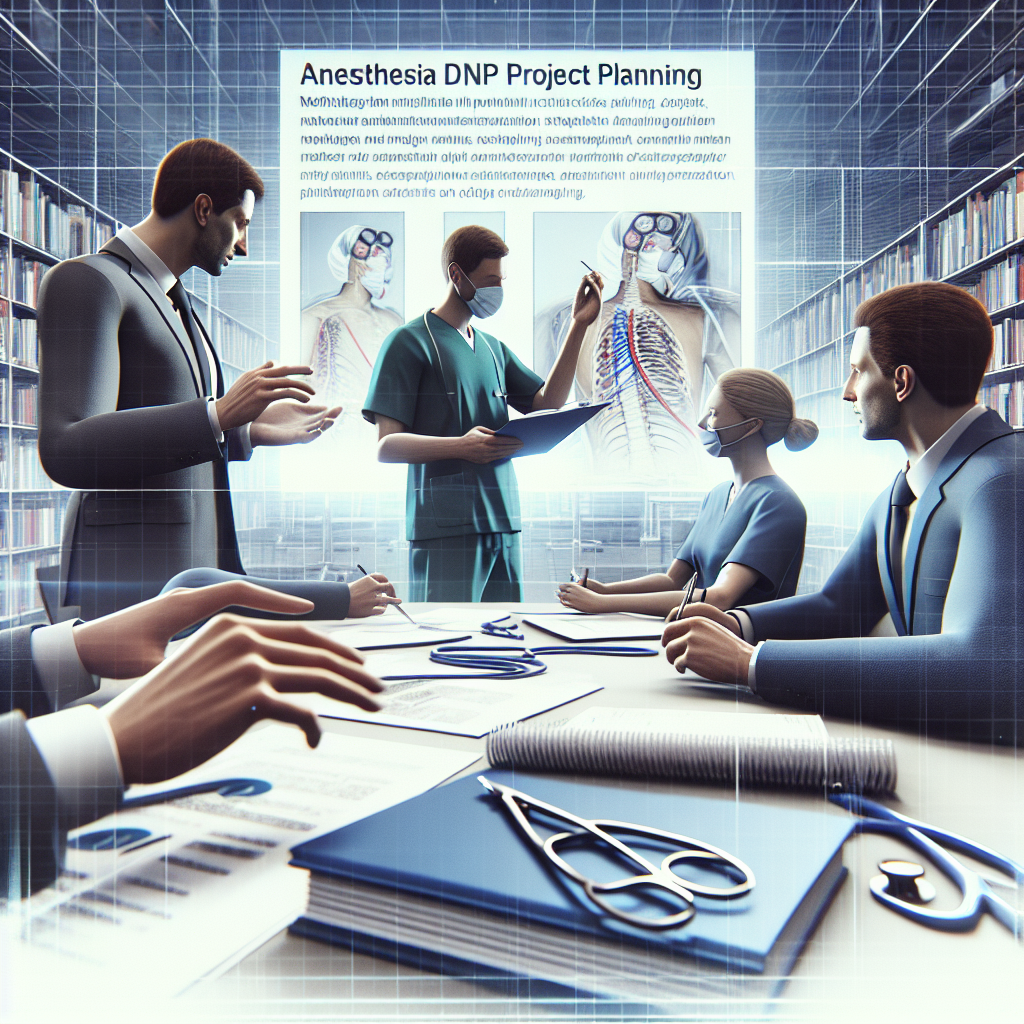The Ultimate Guide to Selecting and Planning DNP Projects in Anesthesia6 min read

Are you a DNP student in anesthesia struggling to choose the perfect project topic? Selecting and planning a high-quality DNP project can be overwhelming, but with the right guidance, you can develop a meaningful and impactful study. This comprehensive guide provides essential tips and strategies for selecting, planning, and implementing successful DNP projects in anesthesia.
Understanding the Purpose of DNP Projects in Anesthesia
Before diving into project ideas, it’s crucial to grasp the fundamental purpose of DNP projects in anesthesia. These projects aim to:
- Address current challenges in anesthesia practice
- Improve patient outcomes and safety
- Enhance the quality of anesthesia care
- Contribute to evidence-based practice in anesthesia
By understanding these goals, you can better align your project with the overall objectives of the DNP program and the anesthesia specialty.
Identifying Potential Project Topics
The first step in selecting a DNP project is to identify potential topics that align with your interests and the needs of the anesthesia field. Consider the following strategies:
Conduct a Literature Review
Perform a comprehensive literature review to identify gaps in current anesthesia research and practice. Look for areas where further investigation could lead to meaningful improvements in patient care or outcomes.
Consult with Anesthesia Professionals
Engage with experienced anesthesia professionals, such as practicing CRNAs, anesthesiologists, or faculty members, to gain insights into current challenges and opportunities in the field. They can provide valuable guidance on relevant project topics.
Reflect on Personal Experiences
Draw from your own clinical experiences in anesthesia to identify potential areas for improvement. Consider challenges you’ve encountered or observations you’ve made that could form the basis of a meaningful project.
Developing a Strong Research Question
Once you’ve identified a potential topic, the next step is to develop a clear and focused research question. A well-crafted research question should:
- Be specific and measurable
- Address a significant problem or gap in anesthesia practice
- Be feasible to investigate within the scope of a DNP project
- Have the potential to generate meaningful findings and recommendations
Examples of strong research questions in anesthesia could include:
- “What is the impact of implementing a standardized pre-anesthesia checklist on patient safety outcomes in the operating room?”
- “How does the use of a multimodal pain management protocol affect postoperative pain scores and opioid consumption in patients undergoing total knee arthroplasty?”
Selecting an Appropriate Methodology
The methodology you choose for your DNP project should be guided by your research question and the goals of your study. Common methodologies for anesthesia DNP projects include:
Quality Improvement Projects
Quality improvement (QI) projects focus on implementing and evaluating interventions designed to enhance the quality of anesthesia care. These projects often involve collecting pre- and post-intervention data to assess the impact of the implemented changes.
Evidence-Based Practice Projects
Evidence-based practice (EBP) projects involve applying the best available evidence to address a specific clinical problem or question in anesthesia. These projects typically include a systematic review of the literature and the development of practice guidelines or protocols based on the findings.
Clinical Practice Projects
Clinical practice projects aim to improve patient outcomes by implementing and evaluating new clinical interventions or protocols in anesthesia practice. These projects often involve collaborating with interdisciplinary teams to design and implement practice changes.
Planning for Successful Implementation
Effective project planning is essential for the successful implementation of your DNP project. Key considerations include:
Identifying Stakeholders and Collaborators
Identify the key stakeholders and collaborators who will be involved in or impacted by your project. This may include anesthesia providers, surgeons, nurses, administrators, and patients. Engage these stakeholders early in the planning process to ensure their support and participation.
Developing a Timeline and Budget
Create a realistic timeline for your project, taking into account the various stages of planning, implementation, data collection, and analysis. Consider the resources and budget required to successfully complete your project, and secure necessary approvals and funding.
Establishing Evaluation Metrics
Define clear and measurable evaluation metrics to assess the success of your project. These metrics should be directly tied to your research question and the goals of your study. Examples may include patient satisfaction scores, complication rates, or adherence to clinical guidelines.
Navigating Ethical Considerations
Anesthesia DNP projects must adhere to ethical principles and guidelines to ensure the protection of patient rights and welfare. Important ethical considerations include:
Obtaining Institutional Review Board (IRB) Approval
Before beginning your project, you must obtain IRB approval to ensure that your study meets ethical standards and protects the rights of human subjects. This process involves submitting a detailed project proposal and addressing any potential risks or ethical concerns.
Maintaining Patient Confidentiality
Ensure that all patient data collected during your project is kept confidential and secure. Use appropriate data management and storage practices, and adhere to HIPAA regulations to protect patient privacy.
Informed Consent and Voluntary Participation
If your project involves human subjects, you must obtain informed consent from participants and ensure that their participation is voluntary. Provide clear information about the purpose, risks, and benefits of the study, and respect participants’ right to withdraw at any time.
FAQs
How do I know if my DNP project idea is feasible?
To determine the feasibility of your project idea, consider factors such as the availability of resources, the timeline for completion, and the potential impact on patient care. Consult with your faculty advisor and experienced anesthesia professionals to assess the practicality of your proposed project.
Can I change my project topic after starting the DNP program?
While it’s best to have a clear project idea from the outset, it’s not uncommon for students to refine or adjust their topics as they progress through the program. If you find that your initial topic is no longer feasible or relevant, consult with your faculty advisor to explore alternative options.
How can I ensure the success of my DNP project?
To maximize the success of your DNP project, start by selecting a topic that aligns with your interests and the needs of the anesthesia field. Develop a clear research question, choose an appropriate methodology, and engage key stakeholders throughout the planning and implementation process. Regularly communicate with your faculty advisor and committee members to receive guidance and feedback.
Conclusion
Selecting and planning a DNP project in anesthesia can be a challenging but rewarding process. By understanding the purpose of these projects, identifying relevant topics, developing a strong research question, and planning for successful implementation, you can create a meaningful and impactful study that contributes to the advancement of anesthesia practice and patient care.
Remember to leverage the expertise of your faculty advisors, experienced anesthesia professionals, and peers throughout the project planning process. With careful consideration and dedication, your DNP project can serve as a valuable foundation for your future career in anesthesia and make a lasting impact on the field.
